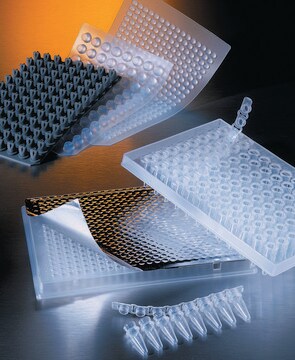3013
Transcreener® ADP2 FI Assay
Sinónimos:
ADP Assay Kit, Transcreener ADP Assay
Iniciar sesiónpara Ver la Fijación de precios por contrato y de la organización
About This Item
Código UNSPSC:
41122100
NACRES:
NA.84
Productos recomendados
Condiciones de envío
dry ice
temp. de almacenamiento
−20°C
Descripción general
The Transcreener® HTS Assay platform overcomes the need for time-consuming, one-off assay development for individual members within a group transfer enzyme family by utilizing a single set of assay reagents that detect an invariant product. The generic nature of the Transcreener® HTS Assay platform eliminates delays involved in assay development for new HTS targets, and greatly simplifies compound and inhibitor profiling across multiple target families.
The Transcreener® ADP2 fluorescent intensity (FI) assay extends the Transcreener® platform for ADP detection by utilizing a simple fluorescent intensity output which can be used on both fluorescence readers typically found in academic and therapeutic research labs as well as more complex multimode plate readers more commonly used in core facilities and HTS labs. The Transcreener® ADP2 FI Assay is a red, competitive fluorescence intensity (FI) assay based on the detection of ADP and therefore is compatible with any enzyme class that produces ADP, including protein, lipid, and carbohydrate kinases, ATPases, DNA helicases, carboxylases and glutamine synthetase. The Transcreener® ADP2 Assay is a simple one step homogenous detection assay, and is flexible with regard to ATP concentration (0.1 to 100 μM ATP). The assay provides excellent signal at low substrate conversion, with a Z′ = 0.7 at 2.5% ATP conversion using 1 μM ATP.
The Transcreener® ADP2 FI Assay was developed to follow the progress of any enzyme that produces ADP. The Transcreener® ADP Detection Mixture comprises a quenched ADP Alexa594 Tracer bound to the ADP2 monoclonal antibody conjugated to an IRDye® QC-1 quencher licensed from LI-COR®. The tracer is displaced by ADP, the invariant product generated during an enzyme reaction. The displaced tracer becomes un-quenched in solution leading to a positive increase in fluorescence intensity. Therefore, ADP production is proportional to an increase in fluorescence. The red tracer minimizes interference from fluorescent compounds and light scattering.
View full Transcreener® product list
The Transcreener® ADP2 fluorescent intensity (FI) assay extends the Transcreener® platform for ADP detection by utilizing a simple fluorescent intensity output which can be used on both fluorescence readers typically found in academic and therapeutic research labs as well as more complex multimode plate readers more commonly used in core facilities and HTS labs. The Transcreener® ADP2 FI Assay is a red, competitive fluorescence intensity (FI) assay based on the detection of ADP and therefore is compatible with any enzyme class that produces ADP, including protein, lipid, and carbohydrate kinases, ATPases, DNA helicases, carboxylases and glutamine synthetase. The Transcreener® ADP2 Assay is a simple one step homogenous detection assay, and is flexible with regard to ATP concentration (0.1 to 100 μM ATP). The assay provides excellent signal at low substrate conversion, with a Z′ = 0.7 at 2.5% ATP conversion using 1 μM ATP.
The Transcreener® ADP2 FI Assay was developed to follow the progress of any enzyme that produces ADP. The Transcreener® ADP Detection Mixture comprises a quenched ADP Alexa594 Tracer bound to the ADP2 monoclonal antibody conjugated to an IRDye® QC-1 quencher licensed from LI-COR®. The tracer is displaced by ADP, the invariant product generated during an enzyme reaction. The displaced tracer becomes un-quenched in solution leading to a positive increase in fluorescence intensity. Therefore, ADP production is proportional to an increase in fluorescence. The red tracer minimizes interference from fluorescent compounds and light scattering.
View full Transcreener® product list
Cantidad
3013-A = 200 assay, 96-well
3013-1K = 1,000 assay, 384-well
3013-10K = 10,000 assay, 384-well
3013-1K = 1,000 assay, 384-well
3013-10K = 10,000 assay, 384-well
Forma física
Kit with buffered aqueous solutions
Información legal
IRDye is a registered trademark of LI-COR, Inc.
LI-COR is a registered trademark of LI-COR, Inc.
Transcreener is a registered trademark of BellBrook Labs
Palabra de señalización
Warning
Frases de peligro
Consejos de prudencia
Clasificaciones de peligro
Eye Irrit. 2
Código de clase de almacenamiento
12 - Non Combustible Liquids
Clase de riesgo para el agua (WGK)
WGK 3
Punto de inflamabilidad (°F)
Not applicable
Punto de inflamabilidad (°C)
Not applicable
Elija entre una de las versiones más recientes:
Certificados de análisis (COA)
Lot/Batch Number
¿No ve la versión correcta?
Si necesita una versión concreta, puede buscar un certificado específico por el número de lote.
¿Ya tiene este producto?
Encuentre la documentación para los productos que ha comprado recientemente en la Biblioteca de documentos.
Sungsoon Fang et al.
Nature medicine, 21(2), 159-165 (2015-01-07)
The systemic expression of the bile acid (BA) sensor farnesoid X receptor (FXR) has led to promising new therapies targeting cholesterol metabolism, triglyceride production, hepatic steatosis and biliary cholestasis. In contrast to systemic therapy, bile acid release during a meal
H Wada et al.
Journal of bacteriology, 175(2), 544-547 (1993-01-01)
Thylakoid membranes isolated from the cyanobacterium Synechocystis sp. strain PCC6803 were capable of desaturating the acyl groups in monogalactosyl diacylglycerol. This desaturation reaction required the reduced form of ferredoxin.
Nuestro equipo de científicos tiene experiencia en todas las áreas de investigación: Ciencias de la vida, Ciencia de los materiales, Síntesis química, Cromatografía, Analítica y muchas otras.
Póngase en contacto con el Servicio técnico





